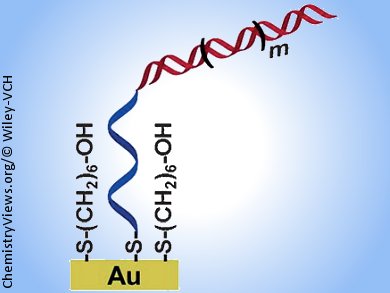Reversible polymerization allows materials to be more easily reused and even to heal themselves, but many methods require conditions that are not compatible with biological applications. Korean researchers avoided such problems by using enzymes to polymerize and depolymerize DNA on a gold surface under physiological conditions.
The team, led by Insung Choi, Korea Advanced Institute of Science and Technology (KAIST), used appended thiol groups to attach four different kinds of palindromic short DNA primers to a gold surface, forming a mixed self-assembled monolayer. The enzyme Taq DNA polymerase catalyzed the growth of different DNA strands according to the nature of the primer. This process can be reversed by sequence-specific restriction enzymes, each of which digested only one of the different kinds of strands. Subsequent re-addition of the polymerase again results in chain growth.

Ellipsometry and atomic force microscopy were used to characterize the film thickness and to confirm the success of each of the steps in the polymerization–depolymerization–repolymerization cycle. The authors comment that their work should facilitate future construction of smart nanostructures and sequence-sensitive biochips.
- Surface-Initiated, Reversible Polymerization from Surface-Tethered Oligonucleotides by Enzymatic Processes,
Jungkyu K. Lee, Mi Rae Kim, Insung S. Choi, Yang-Gyun Kim, Young Hwan Jung,
Chem. Asian J. 2013, 8.
DOI: 10.1002/asia.201201092




